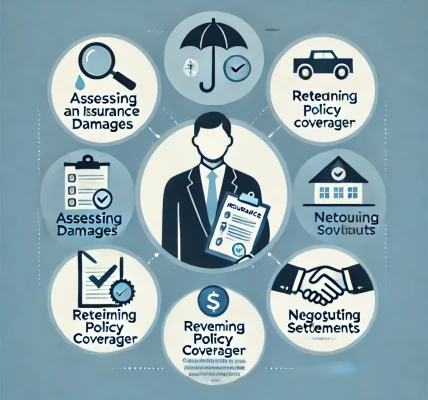Natural disasters can cause devastating losses, making insurance claims essential for recovery. However, filing claims after a disaster can be overwhelming due to high volumes of claims, complex policies, and potential delays. This guide will help you understand how natural disasters impact insurance claims and provide actionable steps to ensure a smooth claims process.
Understanding the Impact of Natural Disasters on Insurance Claims
1. Increased Claim Volume & Processing Delays
When a natural disaster strikes, insurers receive an influx of claims, leading to delays in processing. Since insurance companies prioritize claims based on severity and impact, smaller claims might take longer to settle.
2. Policy Limitations & Exclusions
Not all damages caused by natural disasters are covered by standard policies. For instance:
- Homeowners’ Insurance may cover wind damage but exclude floods and earthquakes.
- Auto Insurance may require comprehensive coverage to cover flood or hail damage.
- Business Insurance might not cover income loss unless specific coverage is added.
3. Higher Scrutiny & Investigations
Insurers thoroughly assess claims for potential fraud or misrepresentation. They may request additional documentation, inspections, or proof of loss before approving a claim.
4. Deductibles & Higher Costs
Some policies have separate deductibles for natural disasters. For example:
- Hurricane deductibles are often a percentage of the insured property value instead of a fixed amount.
- Earthquake insurance may have high deductibles, making smaller claims less viable.
Step-by-Step Guide to Filing an Insurance Claim After a Natural Disaster
Step 1: Prioritize Safety & Document Damage
✔ Ensure you and your family are safe before assessing damages. ✔ Take clear photos and videos of all affected areas to document losses. ✔ Keep damaged items until your insurance adjuster has inspected them.
Step 2: Review Your Insurance Policy
✔ Check your policy to understand coverage limits, exclusions, and deductibles. ✔ Note deadlines for filing claims, as missing them may result in denial. ✔ Identify any additional living expenses (ALE) coverage for temporary housing if needed.
Step 3: Contact Your Insurance Provider Immediately
✔ Notify your insurer as soon as possible to start the claims process. ✔ Ask about the required documents and steps to prevent claim delays. ✔ Request a claim reference number for tracking purposes.
Step 4: Make Temporary Repairs to Prevent Further Damage
✔ Cover broken windows, damaged roofs, or leaks to prevent further loss. ✔ Keep receipts for all repair expenses, as they may be reimbursable. ✔ Avoid making permanent repairs before the adjuster’s inspection.
Step 5: Work with the Insurance Adjuster
✔ Schedule an inspection with the insurance adjuster to assess damages. ✔ Provide all necessary documents, including:
- Photos/videos of damage
- Receipts for repairs and replacements
- Inventory of lost/damaged items ✔ Keep records of all communications with your insurer.
Step 6: Understand Your Settlement Offer
✔ If the insurer offers a lower amount than expected, request a detailed explanation. ✔ Consider getting independent repair estimates to compare with the insurer’s assessment. ✔ Negotiate if needed, and don’t accept an offer that doesn’t cover your losses fairly.
Step 7: Appeal If Your Claim Is Denied
✔ Review the denial letter to understand the reasons. ✔ Provide additional evidence if necessary. ✔ Consider legal or professional assistance, such as a public adjuster or attorney, if disputes arise.
Tips for a Smoother Claims Process
✅ Maintain Updated Records: Keep an inventory of your possessions, including receipts, photos, and serial numbers. ✅ Bundle Coverage Where Possible: Ensure you have all necessary coverages, including flood, earthquake, and business interruption insurance. ✅ Prepare in Advance: Know your policy details and emergency contacts before disaster strikes. ✅ Use Technology: Many insurers offer mobile apps for faster claims filing and tracking.
Conclusion: Be Prepared & Act Quickly
Filing an insurance claim after a natural disaster can be stressful, but with the right approach, you can ensure a smoother process. Prioritize safety, document everything, and communicate effectively with your insurer. By understanding your policy and taking proactive steps, you can maximize your chances of a successful claim settlement.




